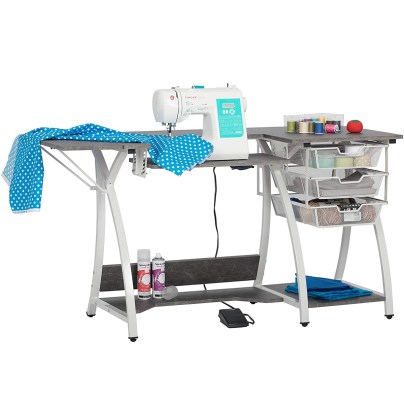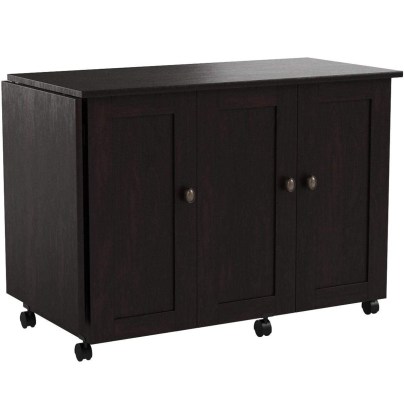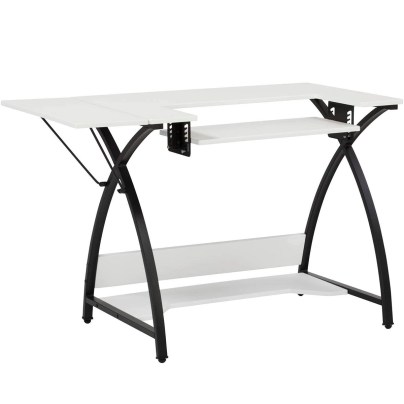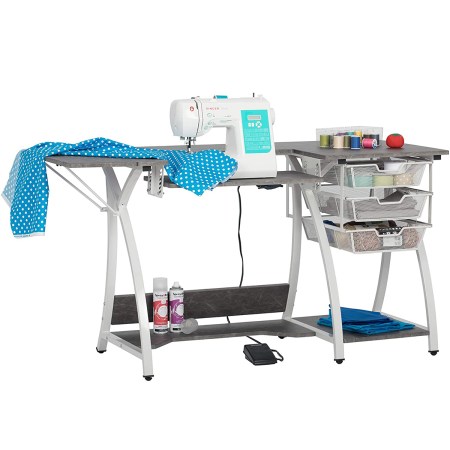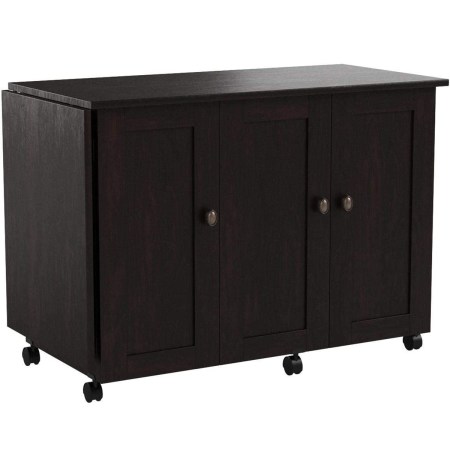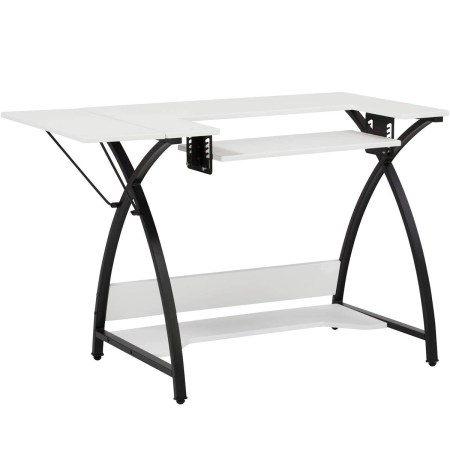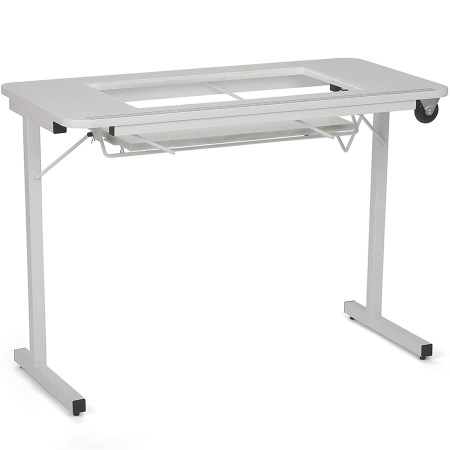We may earn revenue from the products available on this page and participate in affiliate programs. Learn More ›
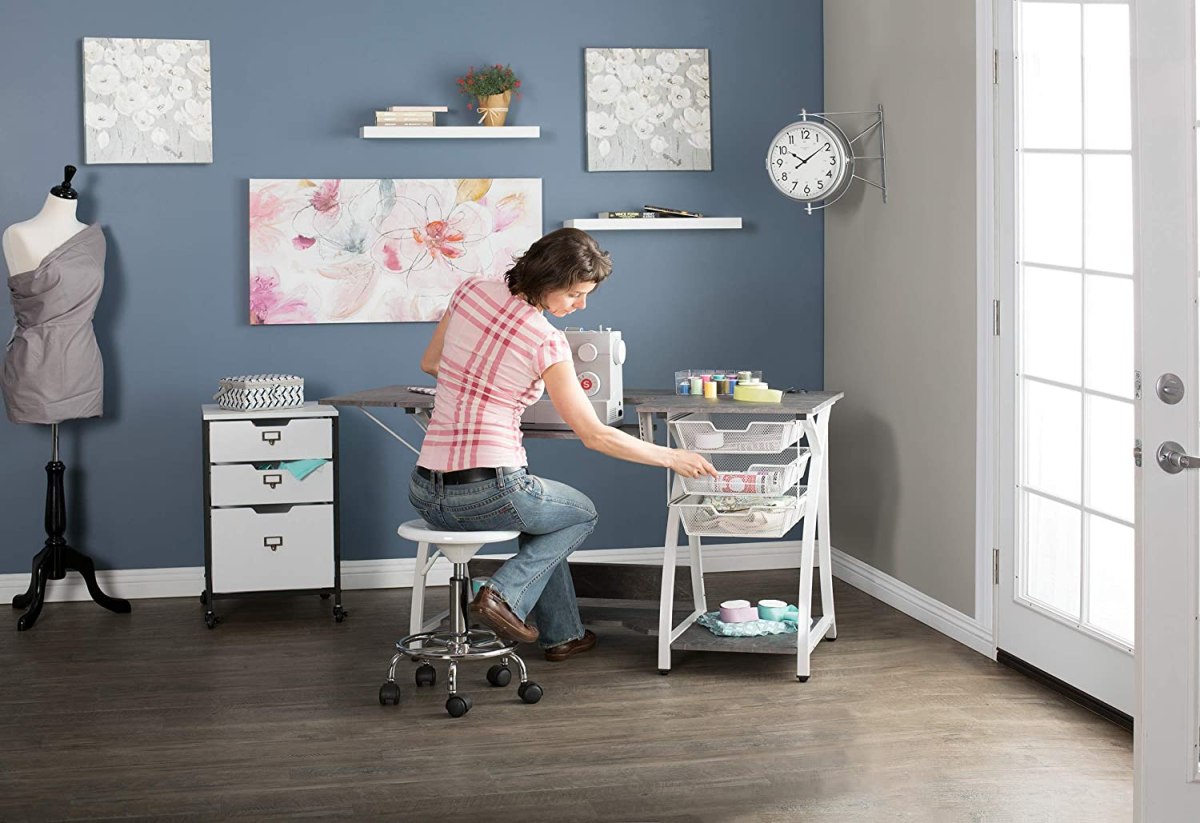
Any project around the home is easier to tackle with the proper tools to get the job done. When working on larger fabric projects, a good sewing table can mean the difference between frustration and satisfaction with the process.
The best sewing table for you will be just the right size for your projects and the space available. The table should also complement your existing home decor, have an appropriately sized and adjustable shelf to hold your sewing machine, as well as the nooks, crannies, and drawers necessary to contain your supplies.
If you’re short on space in your home, portable sewing tables can be excellent solutions, especially if projects don’t tend to take long. Sewing tables that fold up and slide out of sight under a bed or in a closet are great for compact spaces.
Read on for factors to consider when selecting a sewing table, and why the models below are among the best.
- BEST OVERALL: Sew Ready Eclipse Hobby Sewing Center
- BEST STORAGE: Sauder Select Collection Sewing and Craft Table/Cart
- BEST COMPACT: Sew Ready Comet Sewing Table Multipurpose/Sewing Desk
- BEST FOLDING: Arrow Sewing Cabinets 611 Gidget II Table
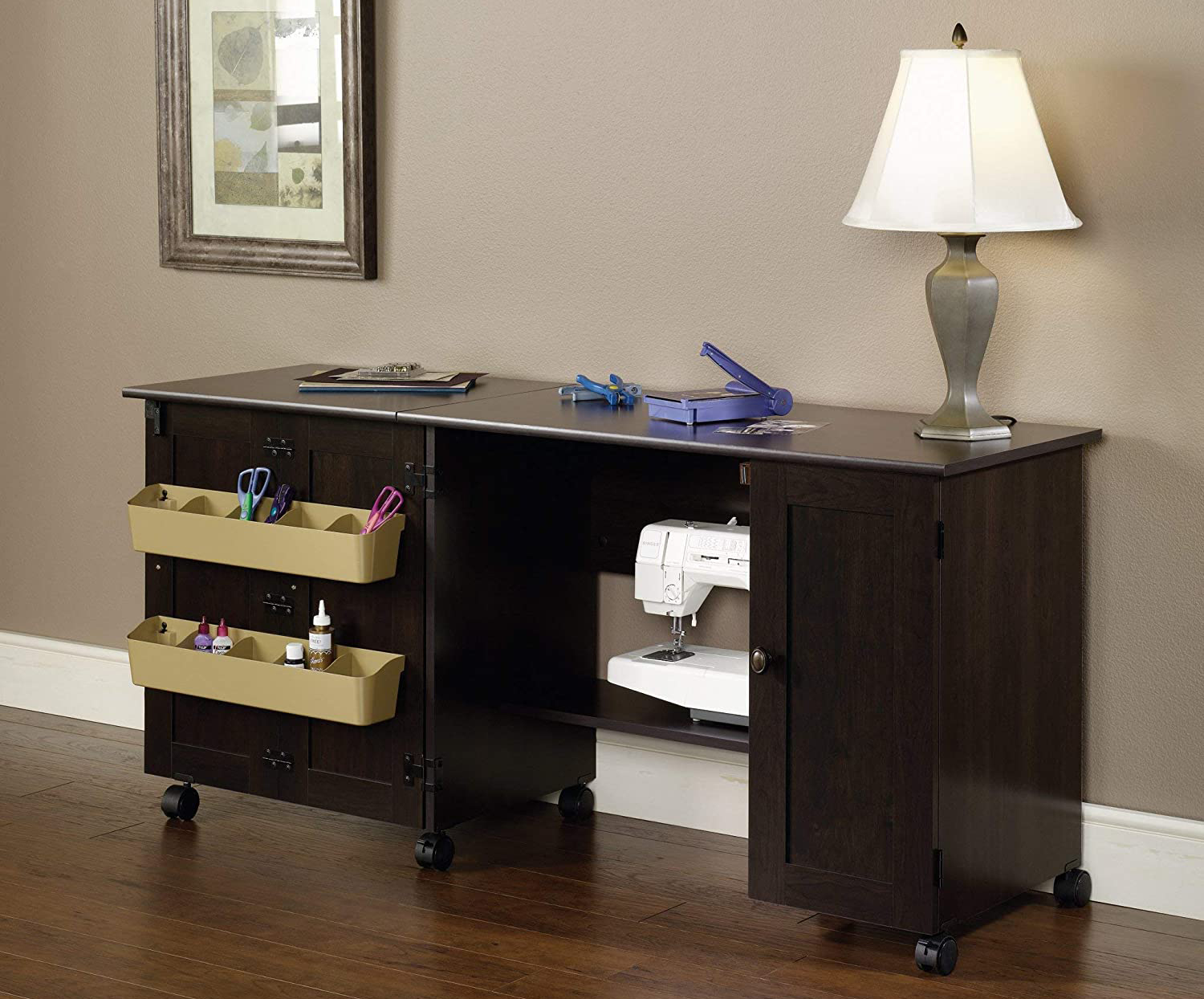
What to Consider When Choosing the Best Sewing Table
When selecting the best sewing table for your fabric projects, there are a variety of factors to consider. It’s not ideal to settle on a sewing table with specific features, only to decide on an upgrade or different style. Keeping the following shopping considerations in mind can help you find a suitable table for your sewing projects.
Material
Most sewing tables contain either wood, particle board, melamine, plastic, or metal:
- Wood sewing tables are sturdy, providing a stable surface for the long hours of vibrations from a sewing machine. Wood also absorbs sound somewhat, so the machine’s noise won’t carry as much through the home.
- Particle board and melamine sewing tables have the classic look of wood but might not be as sturdy in the long run. These materials are generally more affordable than wood.
- Plastic sewing tables are another affordable option, but scratches, nicks, and marks will show more on this material. Plastic also has poor sound absorption; in fact, some plastic sewing tables amplify the sound of your sewing machine.
- Metal sewing tables offer the most durability and can vary in price. They’re usually made of steel or a more lightweight aluminum, the former option offering more affordability.
Size
The best sewing table must be able to accommodate a full-size sewing machine with room to spare. There should be space to maneuver fabric pieces around the machine and, ideally, room for other sewing equipment, such as a serger. When working on a small project, a basic sewing table usually suffices. On the other hand, working on a quilt or other large-scale project would benefit from a sizable table.
If there is not much space in your home for a piece of furniture dedicated to sewing, the best sewing table for your needs might be one with drop-leaf extensions. When the project you’re working on requires more room, simply pull out the sewing table from its usual place, lift or insert those extensions, and you have more space. Depending on the table, leaves can attach on either side to hold accessories, or they might attach into the middle for better stability.
Storage
A sewing table that holds the basics, such as the sewing machine itself as well as bobbins, thread, ribbons, needles, and the like, might be enough for beginners. For those who are serious about sewing as a hobby (or if sewing is their trade), the amount of storage a sewing table has is a more important consideration.
Tables with drawers, shelves, and ledges of all sizes can easily hold the variety of accoutrements that come along with a serious sewing habit. That storage might be open, with racks to hold thread or small jars to hold tiny pieces, and it might include large baskets in which to stow fabric. Other sewing tables might incorporate a closed cabinet, in which you stow needles, scissors, and other accessories. Closed storage is a good idea for homes with small children or pets.
Adjustability
As with many other things in life, one size does not fit all. That’s especially the case with sewing machines and the tables that hold them. A sewing table that can be adjusted to move a few inches up or down, to accommodate different user heights and arm lengths, is ideal. As is a table that will adjust to accommodate different sewing machine sizes.
Most sewing tables are between 28 and 30 inches high, with an adjustable shelf that can be lowered up to 5 inches. This can be useful for a variety of smaller projects, while keeping the machine flush with the surface can help with larger tasks.
Portability
The ability to move a sewing table can be quite helpful, especially if it is used in an area that isn’t dedicated to sewing, such as the end of a hallway or a dining room nook. Look for a sewing table that has sturdy wheels that spin easily and lock down firmly to keep the table steady when in use.
For those who want to stow their sewing table when it’s not in use or move it from one room to another: look for models that are light enough to carry and fold easily. If the table will be stored when it’s not in use, make sure it folds flat enough to fit underneath a bed or in another out-of-the-way spot.
Aesthetic
One aspect of sewing table aesthetic relates storage visibility. Some sewers might choose a table that remains open, keeping the contents of shelves and drawers in full view. These tables usually have open racks for thread and clear boxes or bins for fabric pieces. Others prefer furniture that leaves only the sewing machine open to view, or even one that closes up completely to hide everything; the latter types tend to look like regular cabinets.
Similar to kitchen and dining tables, sewing tables also come in a variety of colors and finishes to complement different styles of home decor. Sewing tables made of wood, particle board or melamine can vary in aesthetic; such as those featuring a faux distressed finish for a rustic look, a midcentury modern form with slanted legs and a minimalist appearance, or a cleaner, contemporary design.
By comparison, plastic and metal tables are limited in the styles they feature, though options are plenty for color and finish. Some of these sewing tables have a glossy or metallic finish that complements modern and industrial room designs. Others have a more subtle appearance that blends in with surrounding decor. Ultimately, these options are more suitable for functional, no-nonsense sewing tables.
Our Top Picks
The top picks for sewing tables include factors such as the material from which the table is made, storage options that come with the table or can be added on later, the aesthetics of the piece, its size and versatility, and more. Below are the top picks for the best sewing tables for fabric projects.
Best Overall
Sew Ready Eclipse Hobby Sewing Center
See ItThis Sew Ready table features a built-in sewing machine shelf as well as three drawers for fabric storage. It also has a durable powder-coated steel frame with six floor levelers that ensure the table can handle the machine’s vibrations. A cable-management hole with cover keeps power cords neatly corralled.
This sewing table can support even heavy sewing machines as well as plenty of fabric and accessories. When not in use, the versatile Sew Ready can be converted to a craft table, hobby desk, or even a computer desk.
Best Storage
Sauder Select Collection Sewing and Craft Table/Cart
See ItThose who are looking for a sewing table that will blend in well with existing decor may want to consider this Sauder cabinet. The engineered wood has a cinnamon cherry finish, and its melamine top is heat, scratch, and stain resistant. Though this sewing table comes with sturdy rolling caster wheels, it weighs just over 83 pounds, so it’s probably best left in one place.
Two adjustable shelves behind the door hold small supplies, and a hidden bottom shelf keeps the sewing machine safe when the doors are closed. When closed, the unit measures 40 inches long by 19.5 inches deep by 28.5 inches tall. When expanded, its length extends to about 62 inches.
Best Compact
Sew Ready Comet Sewing Table Multipurpose/Sewing Desk
See ItSewing hobbyists looking for a basic small sewing table can get behind this durable alloy steel option from Sew Ready. The 37-pound sewing table measures 45.5 inches wide by 23.5 inches deep by 30 inches high—compact enough to fit into small spaces. The table also comes with four floor levelers to help it stand up to the vibrations of a running sewing machine.
A folding side shelf extends outward when more tabletop space is needed, and a lower storage shelf keeps accessories nearby yet out of the way. The height of the sewing machine shelf is adjustable to accommodate users of various heights. The lightweight Sew Ready table can be moved easily from one room to another, or even set up temporarily where users will be for a short while, such as in front of the television.
Best Folding
Arrow Sewing Cabinets 611 Gidget II Table
See ItFrom Arrow Sewing Cabinets, this table folds up when not in use, so it can be tucked away in a closet or stowed under a bed until it’s time for a new fabric project. The top and adjustable platform are made of melamine while the legs contain sturdy steel. Steel pins hold the legs in place to prevent buckling during use.
When the table is open, its dimensions are 40.25 inches wide by 19.75 inches deep by 28.5 inches tall. When its legs are folded for storage, it’s just 4.5 inches tall. Be sure to measure your sewing machine carefully before purchasing this table, as it accommodates machines up to 12.25 inches deep and 23.5 inches wide.
One advantage of this sewing table is that it arrives already assembled and folded in the box, so it’s ready to go. Be ready with a dedicated sewing kit to hold materials, as this folding sewing table is meant to be slipped out of sight and thus has no drawers or hanging baskets.
FAQs About Sewing Tables
This overview provided a lot of information about the best sewing tables for fabric projects, but you may still have general questions about making the right choice. Here are some answers to common questions on sewing tables.
Q. What makes a good sewing table?
The best sewing table has ample room for your machine and a shelf to hold it. Drawers and shelves for storage are handy, too. If it won’t be a permanent fixture in your space, look for a lightweight table that’s simple to fold up and carry from one place to another.
Q. What height should a sewing table be?
The standard height for a sewing table is 28 inches to 30 inches. Keep in mind that the table should have an adjustable shelf for the sewing machine to be able to lower it to various heights for ease of use.
Q. How do you set up a sewing machine table?
This depends on which sewing table you’ve chosen. Some are sold assembled and ready to go, while others must be folded open or assembled. Others, such as the cabinet style, must be opened to reveal the sewing machine and all accessories.
